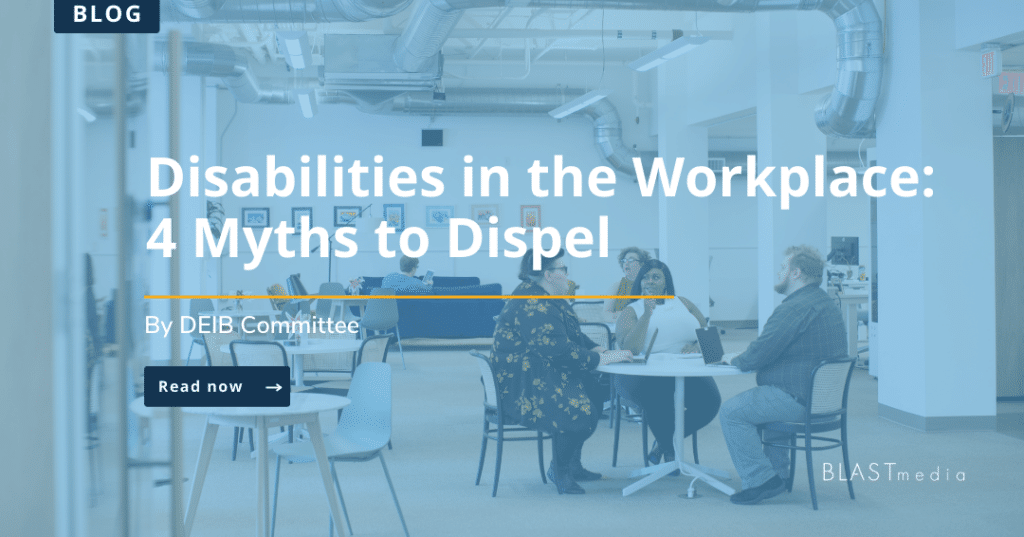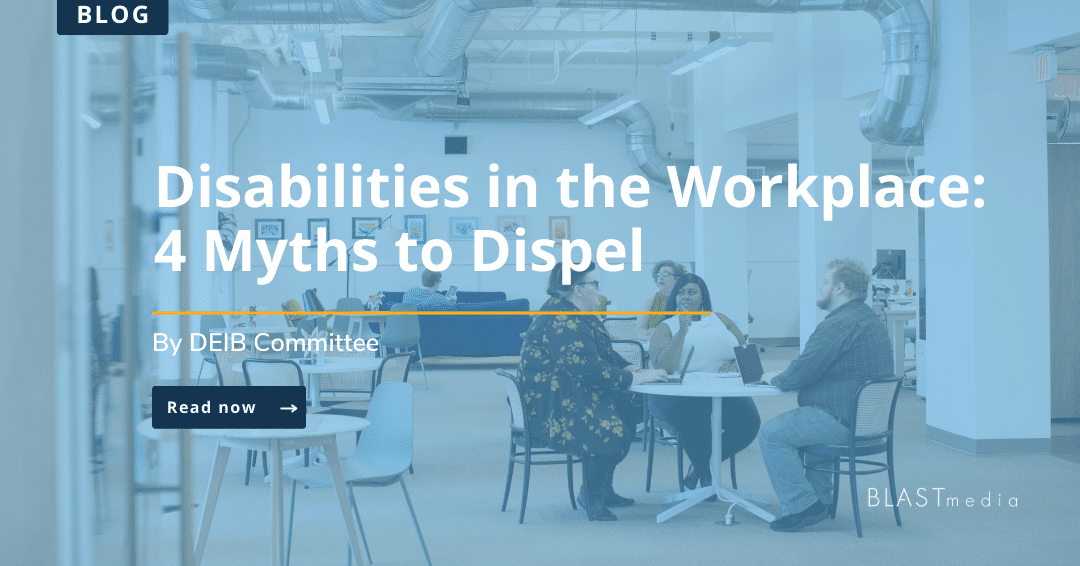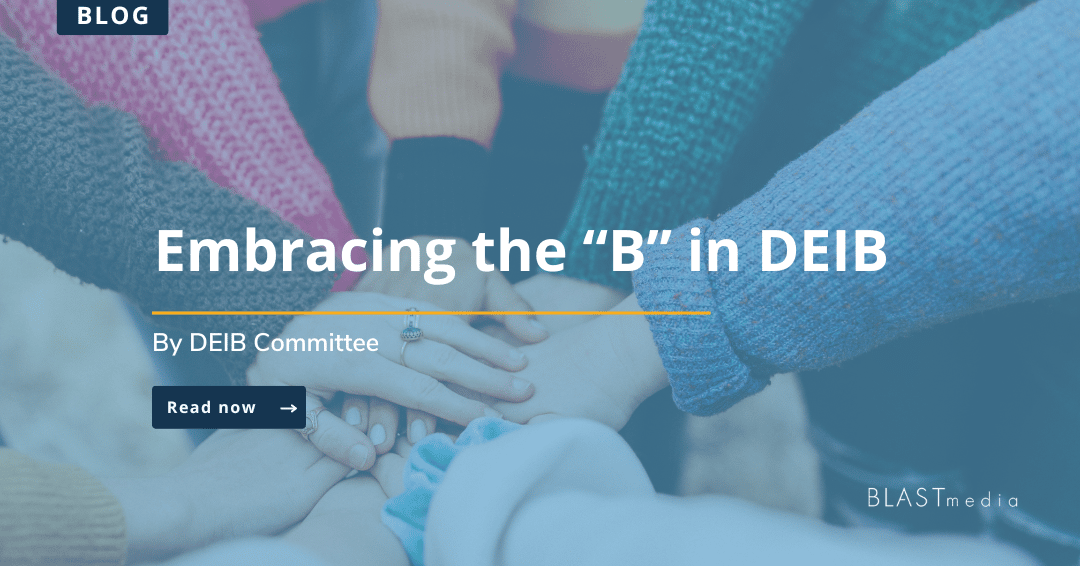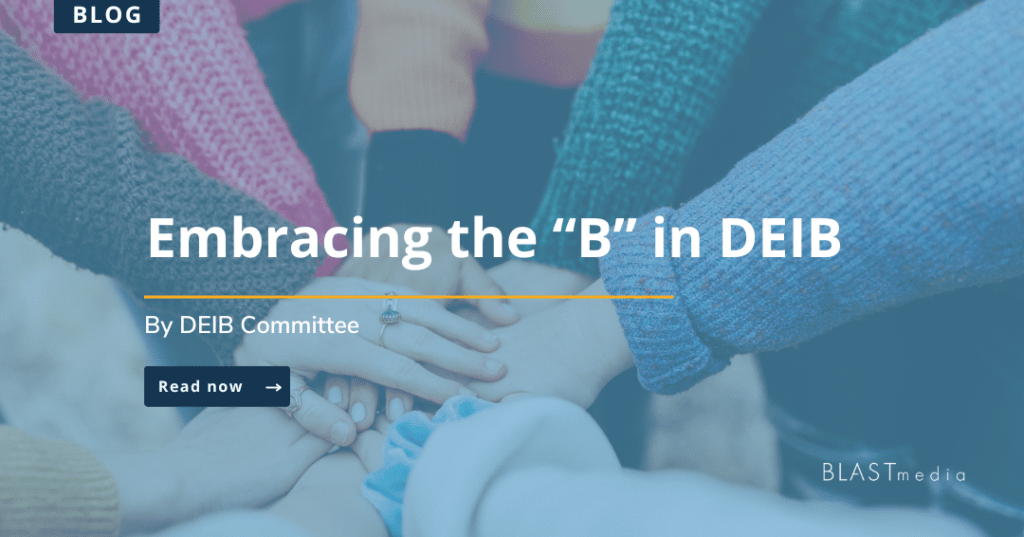
BLAST hosted a recent “Lunch and Learn” session with Nina Slota, Ph.D. Nina, who has a background in education and developmental psychology and a passion for disability studies, shared her professional and personal insights as a person living and working with visible and invisible disabilities.
Discussing disability in the workplace can be intimidating — especially because people may feel undereducated on the topic or unsure where to find resources. Dr. Slota busted four myths about disability in the workplace and offered suggestions on supporting all employees, including those with disabilities.
Myth #1: Everyone with a disability at your workplace has documented it.
Reality: While more than 40 million Americans live with some disability, only 24% of employees with disabilities have fully disclosed their condition at work.
The Centers for Disease Control and Prevention (CDC) defines disability or impairment as a physical or mental impairment creating difficulties for a person to do certain things (activity limitations) or interact with their environment (participation restrictions).
The decision to disclose a disability is personal — and there’s no “typical” list of disabilities people do (or don’t) share with employers. Several factors may influence disclosure, including personal preferences, the nature of the disability, the social and cultural context, and specific circumstances.
People with visible disabilities may be more likely to disclose their disability because it’s visible. Individuals with invisible disabilities, however — like mental health conditions, chronic pain or learning disabilities — may stay quiet for fear of potential stigma, judgment or discrimination. Organizations embracing and championing an employee-first approach can take steps to make it safe for employees to discuss and disclose their disabilities without fear of reprisal or discrimination.
Myth #2: If I can’t see someone’s disability, they don’t have one.
The Invisible Disabilities Association (IDA) defines an invisible disability as “a physical, mental or neurological condition that is not visible from the outside, yet can limit or challenge a person’s movements, senses or activities. Unfortunately, the very fact that these symptoms are invisible can lead to misunderstandings, false perceptions and judgments.”
About 25% of U.S. adults live with a disability, and 20% (or more) of those disabilities are “invisible.” You may have experienced this situation if you’ve seen someone enter or exit a car parked in an accessible parking spot, but the person looks “fine.” If you know someone diagnosed with ADHD or depression, you know someone with an invisible disability.
Myth #3: People with disabilities need medical interventions to navigate their environment.
Actually, no. The social approach changes the environment to help fit the person — and it’s an intrinsic component of the Americans with Disabilities (ADA) Act. A medical model focuses primarily on treating a disability through medical intervention to help the person fit better into their environment. On the other hand, a social model makes immediate changes to the environment, thus making it easier for a person with an impairment to participate.
Companies are required to provide reasonable accommodations for their employees, although there are caveats if doing so would cause undue hardship. However, if an accommodation would prove costly or disruptive — or change operations fundamentally — the employer must find alternatives that wouldn’t pose difficulties to the business.
Myth #4: All accommodations are expensive and take a long time to implement.
While people’s minds might immediately jump to installing an elevator or ramps — most accommodations cost nothing for businesses to implement. According to a survey of over 3,500 employers conducted by the Job Accommodation Network (JAN), of which 720 provided information about accommodation costs:
- 49% said accommodations cost $0 to implement.
- 43% said accommodations carried a one-time cost to implement (an average of $300).
- 7% said accommodations involved an ongoing cost (an average YoY cost of $3,750).
Ways to support employees now
Formal accommodations are made individually and fit to specific individual needs. Dr. Slota calls them “supports” because the ideas may or may not be included in an individual’s reasonable accommodations — and many of these implementations may positively impact everyone.
Think of support or accessibility as a proactive strategy for improving the work environment for all employees. Here are a few cost-free daily supports you can incorporate right now.
- Turn on Zoom captioning, as the program has several options for creating closed captioning (CC) and subtitles for webinars or meetings.
- Use asynchronous communications, including written, emailed or recorded instructions that employees can reference later.
- Provide areas with varied lighting, as certain brightnesses (or light types, like fluorescent lighting) can trigger migraines, and some employees may simply be sensitive to light.
- Create designated quiet areas where employees can go to focus and concentrate, reset or escape the general office hubbub and stimuli.
- Offer remote or hybrid work options so employees can work in the office or from home depending on how they feel and what’s on their calendars any given day.
- When practical, offer flexible workdays or hours to maximize “peak performance,” which can boost morale, improve mental and physical well-being and help employees with disabilities.
- Incorporate project management products that generate visual task lists with images to provide examples of work at various stages — and image-based calendars to mark projected milestones.
- Collaborate with employees to generate backup plans to help eliminate the stress of last-minute or unscheduled changes.
- Give employees a heads-up whenever possible to raise awareness and preparation for significant schedule changes like training session days, office retreats, process improvements or standard operating procedure (SOP) updates.
- Leverage technology like Dictate, Otter.ai, Grammarly, screen-readers, CART, etc.
Why bother?
The Bureau of Labor Statistics finds that businesses with a varied workforce — including people with disabilities — see a 90% increase in employee retention and a 72% increase in employee productivity. Plus, companies hiring people with disabilities demonstrate their commitment to diversity. And according to Deloitte, when employees feel valued, welcomed and supported by their company, they’re 80% more likely to say they work for a high-performing organization.
Does it benefit companies to hire and support people with disabilities? We say, with great enthusiasm, “Yes!”




